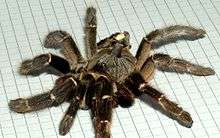Ceratogyrus
Ceratogyrus is a genus of tarantulas found in southern Africa.[1] They are commonly called horned baboons for the foveal horn found on the peltidium in some species. They are readily distinguished from other African theraphosid genera by the combined presence of a retrolateral cheliceral scopula, composed of plumose, stridulatory setae, and the strongly procurved fovea. The fovea is typically strongly procurved and in some species surrounds a distinct protuberance. this protuberance may take the form of a simple posterior extension of the caput, a low-set plug or a prominent, discrete conical projection. All Ceratogyrus species possess a pale yellow anteriorly placed, transverse, sub-abdominal band. This feature is not distinct in other Harpatirinae except Augacephalus junodi. The absence of dense, ventral femoral fringes on the palpi and legs I and II distinguish Ceratogyrus spp. from female A. junodi.
| Ceratogyrus | |
|---|---|
 | |
| Ceratogyrus darlingi | |
| Scientific classification | |
| Kingdom: | Animalia |
| Phylum: | Arthropoda |
| Subphylum: | Chelicerata |
| Class: | Arachnida |
| Order: | Araneae |
| Infraorder: | Mygalomorphae |
| Family: | Theraphosidae |
| Genus: | Ceratogyrus Pocock, 1897[1] |
| Species | |
|
See text. | |
| Synonyms[1] | |
|
Coelogenium Purcell, 1902 | |
C. marshalli features the biggest horn, where it stands straight up about 1 cm. There are several probable functions for this horn: according to a study by Rick C. West in 1986, it provides an increased surface for the attachment of the dorsal dilator muscle, which aids in drawing in liquefied food into the sucking stomach at a faster rate; this way, the spider can retreat to a safe place faster. It also increases the area for the midgut diverticula to expand during times of nutrient and water availability, analogous to a camel's hump, helping it to survive in its arid habitat during droughts.
C. darlingi (often still known under the obsolete name C. bechuanicus) is a rather common terrarium species.
Species
As of February 2019, the World Spider Catalog accepted the following species:[1]
- Ceratogyrus attonitifer Engelbrecht, 2019 – Angola
- Ceratogyrus brachycephalus Hewitt, 1919 – Botswana, Zimbabwe, South Africa
- Ceratogyrus darlingi Pocock, 1897 (type species) – Southern Africa
- Ceratogyrus dolichocephalus Hewitt, 1919 – Zimbabwe
- Ceratogyrus hillyardi (Smith, 1990) – Malawi
- Ceratogyrus marshalli Pocock, 1897 – Zimbabwe, Mozambique
- Ceratogyrus meridionalis (Hirst, 1907) – Malawi, Mozambique
- Ceratogyrus paulseni Gallon, 2005 – South Africa
- Ceratogyrus pillansi (Purcell, 1902) – Zimbabwe, Mozambique
- Ceratogyrus sanderi Strand, 1906 – Namibia, Zimbabwe
- Transferred to other genera
- Ceratogyrus ezendami → Augacephalus ezendami
- Ceratogyrus nigrifemur → Augacephalus nigrifemur
- Ceratogyrus raveni (Smith, 1990) → Pterinochilus chordatus
- In synonymy
- Ceratogyrus bechuanicus (Purcell, 1902) and Ceratogyrus schultzei (Purcell, 1908) = Ceratogyrus darlingi
- Ceratogyrus cornuatus (De Wet & Dippenaar-Schoeman, 1991) = Ceratogyrus marshalli
References
- "Gen. Ceratogyrus Pocock, 1897", World Spider Catalog, Natural History Museum Bern, retrieved 2016-05-20
- Pocock, R.I. (1897). On the spiders of the suborder Mygalomorphae from the Ethiopian Region, contained in the collection of the British Museum. Proceedings of the Zoological Society of London 1897:724-774.
- West, R.C. (1986). Ceratogyrus. Journal of the British Tarantula Society 1(4):79-80.
- Gallon, R.C. (2001). Revision of the Ceratogyrus spp. formerly included in Coelogenium (Araneae: Theraphosidae, Harpactirinae). Mygalomorph 2:1-20. PDF
- Messenger, P. (2004). Captive Breeding Ceratogyrus meridionalis. J. Brit. Tarantula Soc. 19(4):113-117. PDF
- Gallon, R.C. (2005c). A new species of theraphosid spider from Southern Africa (Araneae, Theraphosidae, Harpactirinae) with distributional notes on other harpactirines. Bull. Br. arachnol. Soc. 13(5):179-184. PDF (C. paulseni)
External links
- Reference list
- Photos of three Ceratogyrus species in gallery of tarantulas.
